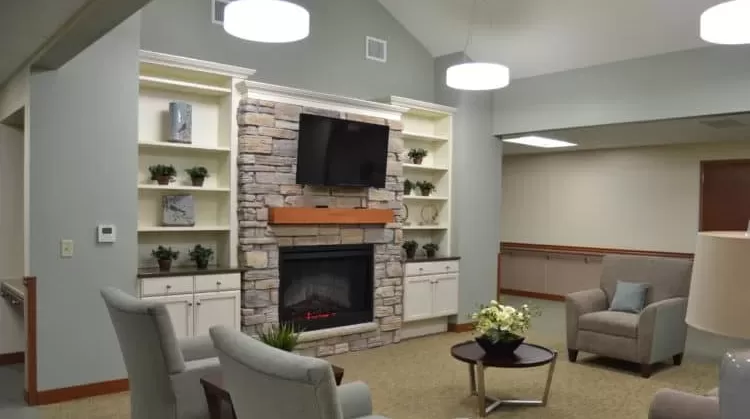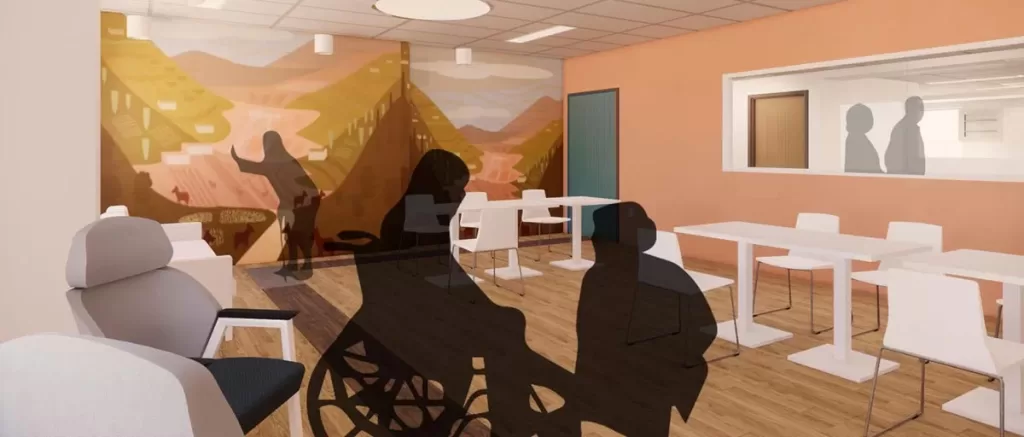Designing for Dementia-Friendly Environments
Estimated Read Time: 6 Minutes
The Highlights
Clear wayfinding & signage help residents navigate safely and independently.
Proper lighting & calming color schemes reduce disorientation and improve mood.
Safety features should protect residents without feeling restrictive.
Sensory design elements reduce anxiety and create soothing, familiar environments.
Community spaces encourage social interaction and meaningful engagement.
Cost-effective construction solutions balance quality with budget-conscious choices.
Proactive maintenance planning ensures long-term functionality and care standards.
For property managers of healthcare facilities and building engineers, assisted living for dementia patients requires careful planning and a well-designed facility. Implementing dementia-friendly elements can significantly enhance the quality of life for residents.
Healthcare facilities designed for safety not only prevent accidents but also enable residents to maintain autonomy and confidence in their surroundings. Here’s how you can create dementia-friendly environments while considering cost-effective construction solutions and long-term maintenance needs.
Wayfinding & Signage: Clear Navigation for Comfort
Patients experiencing dementia frequently encounter challenges in navigation and spatial awareness. Thoughtful healthcare facility design includes clear, readable signage and distinct pathways, helping residents safely and independently navigate nursing homes with dementia units.
Key strategies include:
- Use contrasting colors on walls and floors to define pathways clearly.
- Use large, easy-to-read fonts and universally recognizable symbols for improved comprehension.
- Integrate landmarks and visual cues, like colorful paintings, to serve as cognitive markers that aid memory recall.
- Maintain consistent placement of signage throughout the facility to promote intuitive navigation.
This approach ensures inclusive spaces, promoting senior living safety and reducing patient anxiety.

Lighting & Color Contrast: Enhancing Visibility and Mood
Proper lighting impacts mood, behavior, and safety of dementia residents. A thoughtfully designed lighting system minimizes shadows and glare, essential to dementia and assisted living facilities.
Key strategies include:
- Bright, uniform, non-glare lights reduce disorientation and improve visibility.
- Adjustable lighting aligned with circadian rhythms to promote restful sleep patterns.
- Interior design color schemes with neutral paint colors like accessible beige, offer soothing and calming environments.
- Soothing bedroom paint colors to support restful sleep and relaxation.
Optimizing lighting and color enhances functionality and provides a comfortable, dementia-friendly environment.

Safety & Security Features: Protecting Residents
Safety is crucial for dementia-friendly environments. Proper safety devices ensure security without causing residents to feel overly restricted.
Key features include:
- Specialized dementia door protection and safety door locks for dementia patients, preventing unsafe wandering while maintaining emergency access.
- Dementia safety devices such as safety alarms for seniors, motion-sensor lighting, and wearable alerts.
- Wheelchair accessible showers, handrails, and non-slip flooring to enhance senior living safety and reduce fall risks.
- At-home assisted living modifications, including smart monitoring systems, catering to independent residents.
By integrating these elements, facilities create secure spaces designed for safety and peace of mind for residents, families, and caregivers.
Sensory Design: Creating Calming Atmospheres
Residents with dementia often experience heightened sensory sensitivities, thoughtful healthcare facility design significantly reduces stress, anxiety, and confusion.
Key strategies include:
- Incorporate soft textures, familiar patterns, and comforting fabrics to encourage relaxation.
- Minimize noise distractions with acoustic treatments and effective soundproofing.
- Display colorful paintings and engaging art in public spaces, stimulating cognitive activities and positive interactions.
- Create individual support areas for residents to retreat when feeling overwhelmed.
Effective sensory design contributes to a comforting, dementia-friendly environment that supports residents’ well-being and dignity.

Community & Social Spaces: Encouraging Interaction
Social interactions are vital in dementia and assisted living environments. Facilities must thoughtfully design communal areas to promote meaningful interactions and access family care.
Key strategies include:
- Comfortable, flexible seating arrangements encouraging group activities and social engagement.
- Outdoor gardens featuring wheelchair-accessible paths, sensory landscapes, and safe exploration areas.
- Multi-sensory rooms that are designed to both balance relaxation with cognitive stimulation.
- Luxury assisted living facilities equipped with inviting amenities like fireplaces, cozy lounges, and spaces dedicated to family gatherings and community events.
Creating inclusive spaces supports residents’ emotional health and overall quality of life.

Cost-Effective Construction Solutions
Achieving dementia-friendly environments doesn’t have to be financially burdensome. Efficient healthcare facility design can balance affordability with effectiveness.
Cost-saving strategies:
- Utilize modular design principles for flexibility and scalability.
- Select durable, easy-to-maintain materials, reducing long-term operational costs.
- Implement energy-efficient lighting and automated systems to reduce overhead.
- Leverage technology-driven safety devices, enhancing security without extensive structural changes.
These approaches ensure quality construction within budget constraints, benefiting property managers, building engineers, and residents alike.
Maintenance Considerations for Dementia-Friendly Designs
Proper maintenance planning ensures long-term effectiveness and sustainability of dementia-friendly environments. Integrating proactive maintenance practices ensures longevity and consistent quality of care.
Maintenance strategies:
- Regular inspections and updates of safety devices for seniors to maintain peak functionality.
- Easy-to-clean surfaces and durable finishes minimize downtime and maintenance expenses.
- Scheduled testing of emergency systems, alarms, and safety door locks for dementia patients.
- Training maintenance staff in dementia awareness ensures sensitive handling of repairs and inspections.
Final Thoughts: Creating a Safe and Inclusive Future
Designing dementia-friendly environments requires balancing safety, comfort, accessibility, and budget-conscious strategies. Property managers of healthcare facilities and building engineers have the unique responsibility to thoughtfully implement dementia-friendly elements—from carefully chosen paint colors and clear wayfinding signage to advanced dementia safety devices and accessible spaces.
Prioritizing thoughtful, sustainable healthcare facility design significantly improves the daily lives of dementia patients, ensuring dignity, autonomy, and comfort in every aspect of their environment.
Partner with IOC Construction
IOC Construction specializes in creating dementia-friendly, innovative, and cost-effective healthcare environments. Our expertise ensures thoughtful designs that meet your facility’s specific needs. Contact IOC Construction today to learn how we can help your facility deliver exceptional care through thoughtful, compassionate, and sustainable design.
